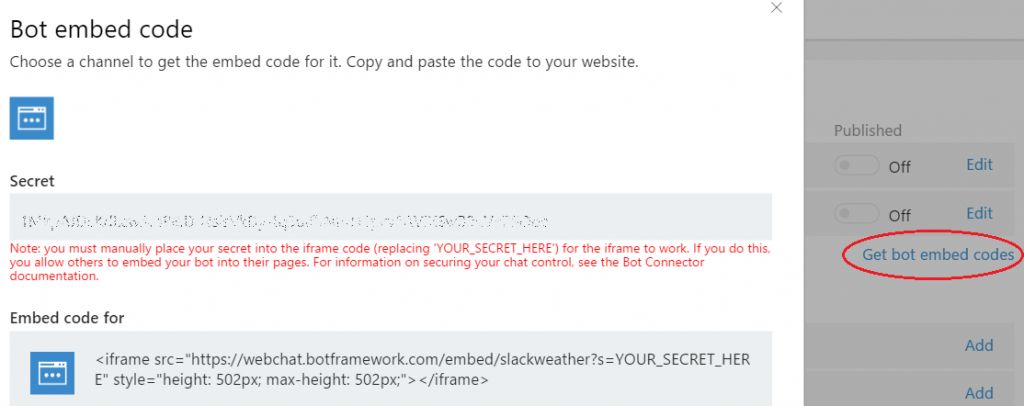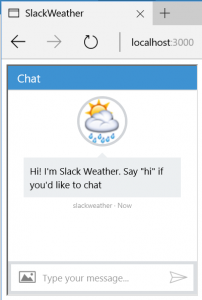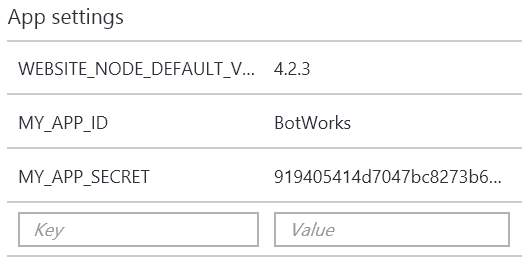Ask Learn
Preview
Ask Learn is an AI assistant that can answer questions, clarify concepts, and define terms using trusted Microsoft documentation.
Please sign in to use Ask Learn.
Sign inThis browser is no longer supported.
Upgrade to Microsoft Edge to take advantage of the latest features, security updates, and technical support.
Note
Access to this page requires authorization. You can try signing in or changing directories.
Access to this page requires authorization. You can try changing directories.
Welcome back to the continuation of Microsoft Bot Framework Part 1, for more information on how to configure new channels with communication services such as Slack and the web. Before we can connect our bot to users on the web, there are a few security measures we'll have to take with our code.
Many REST APIs require an access token. You’ll need to use this access token in your application when accessing the API, but you don’t want to expose your token to users. If you post your code to a public repository like GitHub, anyone can view the code and obtain your key. Slack is smart enough to know when your Slack Token has been posted to GitHub, and it will automatically deactivate that key. A Meetup API key exposes the Meetup groups you've joined, even private groups, so you really don’t want that getting out in the open.
Previously, in Part 1, I told you to go in your app.js code and swap out ‘YourAppId’ and ‘YourAppPassword’ for the values generated when you registered your bot.
var connector = new builder.ChatConnector({ appId: 'YourAppId', appPassword: 'YourAppPassword' });
While that's fine for local debugging and using the Bot Framework Emulator, if we just changed our code from that to this,
var connector = new builder.ChatConnector({ appId: 'BotWorks', appPassword: '9876543210d1234abc5678efg9h0i1jk' });
I wouldn't be able to upload that to GitHub or Azure without introducing the secret keys to the public.
To avoid that, we create Environment Variables on our server that contain the API keys that we want to protect. Whenever we need to access the keys, we use the node global process object to access the key, ‘process.env’.
var appId = process.env.MY_APP_ID,
var appPassword = process.env.MY_APP_PASSWORD;
key: MY_APP_ID value: botworks…
key: MY_APP_PASSWORD value: 9876543210d…
Visual Studio Code has support for debugging and using environment variables. You can skip the configuration and still use the tools. VS Code has these 4 icons on the left sidebar:
To add environment variables to VS Code before uploading your code to GitHub or Azure, you can add them to your launch.json file. When you click on the Debugging icon on the left sidebar, choose Node from the dropdown menu at the top, Launch, and then the Run button. If those files aren't in your project yet, VS Code will create them for you now. Then, just be sure to add .vscode to your .gitignore file.
[video width="1784" height="920" mp4="https://msdnshared.blob.core.windows.net/media/2016/06/VS_env.mp4"][/video]
Don't be discouraged if you visit https://localhost:3000/ in a browser and see some kind of error. We just haven’t built any client-facing front end code yet! (That's what the Bot Emulator is for.) Just go to dev.botframework.com, sign in and click on "My bots" to see your bot dashboard. Click “Get bot embed codes”.

I’d like to create an index.html file so that when I go to MyAppId.azurewebsites.net, I’m greeted by the sunny disposition of my own bot.
In the Node.js cmd prompt, type:
>cls>index.html
[Creates a file called “index.html” in your file explorer. Edit this through VS Code.]
<!doctype html>
<html>
<head>
<title>MyAppID</title>
</head>
<body>
//iframe
</body>
</html>
In the index.html code above, replace //iframe with:
<iframe src="https://webchat.botframework.com/embed/YourAppId?s=YOUR_SECRET_HERE" style="height: 502px; max-height: 502px;"></iframe>
Manually place your Secret into the iframe code (replacing 'YOUR_SECRET_HERE') for the iframe to work. If you do this, you allow others to embed your bot into their pages.
The only thing left to do is to add the following lines of code to your app.js file:
server.get(/\/?.*/, restify.plugins.serveStatic({
directory: __dirname,
default: '/index.html'
}));

Since I am uploading this project onto Azure, I can place the values of my API keys in my project’s application settings. Doing this keeps my secret tokens separate from my code and files, and I can still check in my code to GitHub.
Go back to https://portal.azure.com and click on your web app (BotWorks). In the Settings blade, scroll down until you see General. Click Application Settings to open a new blade. (While we're here, under "General settings," you can set the Azure web app to "Always on." Doing this makes it so Node will never shut off, because your bot might not have a browser to ping. This option is, however, more expensive.)
Scroll down to "App Settings" until you see a set of Key/Value pairs. Copy and paste your AppId in the “Value” form, then create a corresponding variable name in the “Key” form.
Copy and paste your AppPassword in the next “Value” form, then create a similar corresponding variable name in the “Key” form. These names must coincide with the names you used in VS Code, and usually follow an ALL_CAPS naming convention.
Click on the Save icon to save these values. It will look something like this in the Azure portal:

Uploading these variables to our Azure web service is nice, in theory, but it doesn't do us any good if no code has been deployed yet!
In order to get my bot's code working on https://botworks.azurewebsites.net/api/messages, I can continuously deploy my app from GitHub to Azure.
Making a file called app.js will automatically cause Azure to recognize it as a Node.js app. Azure will immediately look for a package.json file and install all dependencies listed therein. Like I mentioned earlier, make sure package.json is up-to-date with your dependencies before you publish to Azure.
First, we'll need to push all local changes to GitHub, without exposing any secret keys.
Try to think of any node modules you might want Azure to install in the future of your bot.
If you want to call a RESTful API, chances are good Node.js has a module for that.
Installing "https" may help you call said API.
If you want to give your bot front-facing HTML content, consider installing "express".
npm install --save [your API of choice]
npm install --save https
export or at runtime.In the Azure Portal, in the Settings blade, scroll down to Publishing and look for the words “Deployment options.” Follow the prompts to select a method of source control. (Options include Visual Studio Team Services, OneDrive, Local Git Repository, GitHub, BitBucket, Dropbox, and External Repository.)
Choose Source: (GitHub) > Authorization: (YourUserName) > Choose your organization: (Personal?) > Choose project: (YourAppID) > Choose branch: (master) > Performance Test: (Not Configured) > OK.
Azure will now start setting up the deployment source. If successful, you may click "Deployment source" again to see it linking up the GitHub repo, building, deploying, fetching changes, and going active.
Now we would like to test our connection to our bot. Your developer dashboard has a test chat window you can use to send test messages to your bot. Microsoft Bot Framework has this reusable chat control that developers can put in their own websites to talk directly with their bots. You can use this tool to interact with your Bot without further configuration, and verify that the Bot Framework can communicate with your Bot’s web service.
(Note that the first request after your Bot starts up can take 20-30 seconds as Azure starts up the web service for the first time. Subsequent requests will be quicker.) This simple viewer will let you see the JSON object returned by your Bot.
Microsoft also invented the Bot Framework Emulator to do much the same thing, but this one only runs on Windows.
Every Azure web site has an associated 'scm' service site, which runs both Kudu and other Site Extensions. If your web site has URL https://YourAppID.azurewebsites.net/, then the root URL of the Kudu service is https://YourAppID.scm.azurewebsites.net/. Note the added scm token.
This service is a pretty cool debugging trick. If you go to "Debug console" > "PowerShell" you will see PowerShell that's actually for the virtual machine that's running your website!
Above that is a folder structure. "site" > "wwwroot" contains your web-facing files. You can actually see what has been deployed here, including node_modules.
If you click on "Process explorer" you can see what apps are running. W3wp.exe will always be running. Node.exe only boots up once someone pings the server through the browser. If you only build a Slack bot, you might want to enable "Always on" so that you don't have to visit YourAppID.azurewebsites.net every time you want your Slack bot to come online, since there's no other browser to ping.
Under "Tools" > "Log stream" you can see anything printed to console log, errors, etc.
As an alternative to debugging in VS Code, you can install Node Inspector globally from NPM. If this is your first time:
If you have already installed node-inspector:
To stop listening and deactivate your bot, go back to the Node.js command prompt and type ^C.
Now, if your Bot is up and running, you can configure it for a communication channel like Slack! Configuring channels is a combination of Microsoft Bot Framework workflow and conversation service workflow, and is unique for each channel you wish to configure.
Ask Learn is an AI assistant that can answer questions, clarify concepts, and define terms using trusted Microsoft documentation.
Please sign in to use Ask Learn.
Sign in